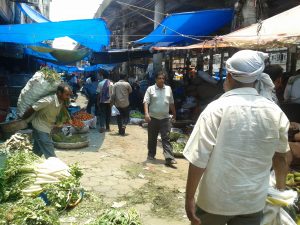News
NEW STUDY: Cities Can Play Important Role in Reducing Environmental Impact of Food Systems
A new study published by SRN researchers in the the journal Environmental Science & Technology introduces a methodology for understanding the impact that city-level policy can have on reducing the overall environmental impact of food systems. See complete findings here.
On global and national scales, the food system is known to have substantial environmental impact, with estimates as high as 85% of global water use and 30% of global greenhouse gas emissions. Yet cities, despite being such large centers of population and food use, remained largely absent from the discussion of how to mitigate these large environmental impacts. The food system has traditionally not been considered a common concern of municipalities, particularly in comparison to other infrastructure sectors, thus the metrics and tools to assess city-level change within the food system are substantially lacking.
Only recently have cities begun reemerging as players in the global food system grappling with food system concerns ranging from health and nutrition of their residents, equity of access, resilience, and environmental sustainability. Evidence of this is seen in recent efforts by global food organizations, including the United Nations Food and Agriculture Organization’s Food for the Cities, C40’s Food Systems Network and the Milan Food Pact, all working to mobilize city-scale food system actions. Examples from the Minneapolis-St. Paul Metropolitan area include the Minneapolis Food Policy Council, Homegrown Minneapolis, a non-profit organization, as well as the City of St Paul through its work to improve food access.
Yet with such a diversity of urban food concerns, the science is lacking to assess the tradeoffs and co-benefits of various city-level actions that affect food policy and food systems. For example, if a city aims to promote a particular diet for improved health, does this complement or conflict with efforts to lessen overall environmental impact?
While the water, energy/greenhouse gas (GHG) and land impact of the global food system has been studied on national and global scales, this paper focuses on actions taken at the city scale that have received little attention. The paper presents a systems methodology to address the important question of: what is the extent to which city-scale actions shape the overall food system’s environmental impact, specifically in terms of GHG, water, and land?
The methodology helps to identify which food systems strategies are co-beneficial and where tradeoffs must be considered in terms of water, energy, GHG and other social impacts (i.e. greater equity, increasing nutrition). The methodology presented is applicable to any city with the requisite data. As cities increasingly emerge as prominent players in the global food system, this research helps cities to understand, quantitatively, their actions in the context of resource constraints and planetary boundaries.
Applied to Delhi India, the work explores future urban food scenarios related to: a) diet-related equity and health; b) sustainable diet change; c) greater local food production through various modes of urban agriculture (soil-based, vertical); d) improved food waste management and e) cooking fuel interventions.


The analysis demonstrates that city-scale action can rival typical food policy interventions that occur at larger scales, although no single city-scale action can rival in all three environmental impacts. In particular, improved food-waste management within the city (7% system-wide GHG reduction) matches the GHG impact of pre-consumer trans-boundary food waste reduction. The systems approach is particularly useful in illustrating key tradeoffs and co-benefits. For instance, multiple diet shifts that can reduce GHG emissions have trade-offs that increase water and land impacts. Vertical farming technology with current applications for fruits and vegetables can provide modest system-wide water (4%) and land reductions (3%), although implementation within the city itself may raise questions of constraints in water-stressed cities, with such a shift in Delhi increasing community-wide direct water use by 16%. Improving the nutrition status for the bottom 50% of the population to the median diet is accompanied by proportionally smaller increases of water, GHG, and land impacts (4%, 9%, and 8%, system-wide): increases that can be offset through simultaneous city-scale actions, e.g., improved food-waste management and vertical farming technologies.
The study, “What Is the Contribution of City-Scale Actions to the Overall Food System’s Environmental Impacts?: Assessing Water, Greenhouse Gas, and Land Impacts of Future Urban Food Scenarios” is published in the journal Environmental Science and Technology by Dana Boyer (PhD Candidate, Science, Technology and Environmental Policy) and Anu Ramaswami (Professor, Denny Chair) of the Center for Science, Technology and Environmental Policy at the Humphrey School of Public Affairs. See the complete findings here.




